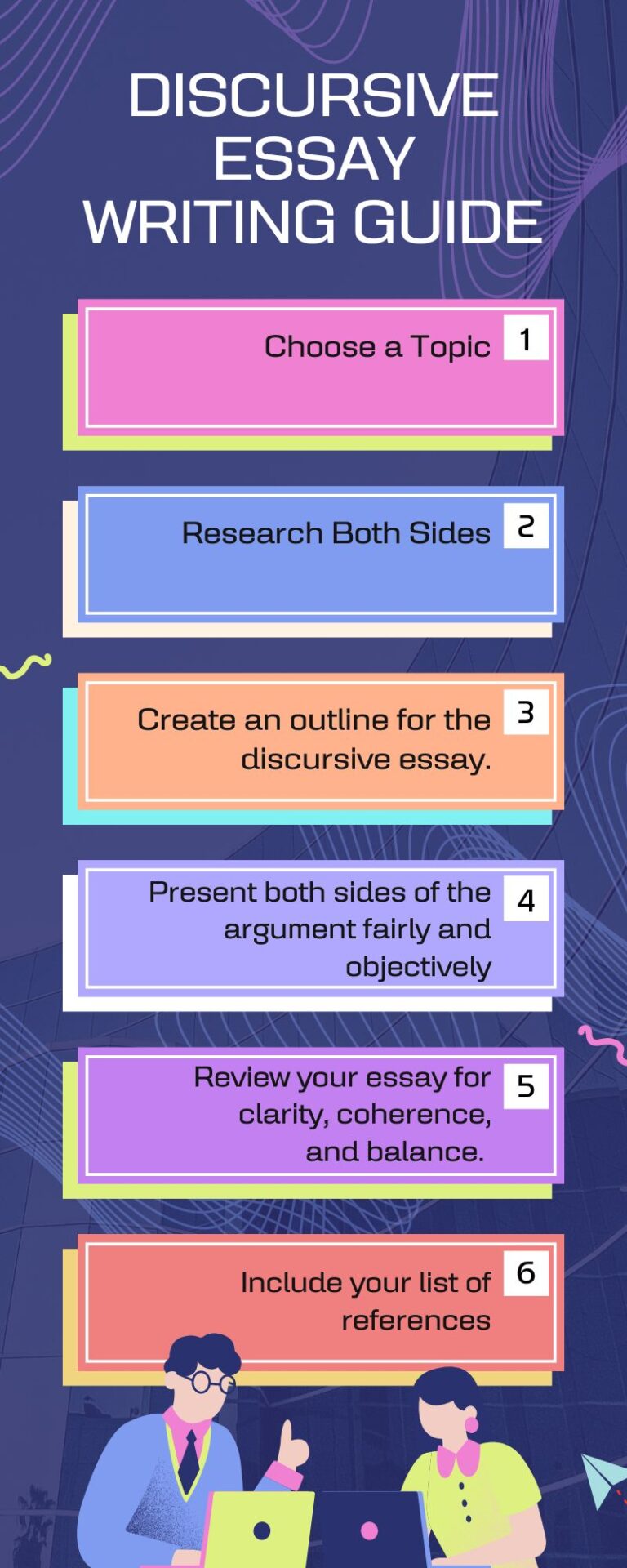Essay Writing Guides
How to Write a Discursive Essay (With Examples)


Writing a discursive essay is an engaging way to explore various perspectives on a topic. Unlike other essay types, discursive essays provide a balanced discussion, presenting different viewpoints and arguments. This type of essay helps develop critical thinking skills and encourages a thorough understanding of the subject.
In this article, we will delve into the intricacies of discursive essays, including their definition, main types, and how they compare to other essay forms. Whether you are a student or a professional writer, mastering the art of discursive writing can enhance your analytical and writing skills.
What is a Discursive Essay
A discursive essay is an essay that presents both sides of an argument or topic without showing personal bias. “Discursive” comes from “discourse,” which involves sharing thoughts on a particular idea. In this essay, you must objectively present the topic’s pros and cons, advantages and disadvantages. The writer remains neutral throughout the essay’s body, only revealing their own opinion in the conclusion, supported by the discussion in the preceding paragraphs. This approach encourages a balanced and comprehensive exploration of the subject matter.
Main Types of Discursive Essays
Discursive essays come in three main types: for and against, opinion, and problem-solution.
- For and Against Essays: These essays present a topic’s positive and negative aspects. The writer discusses arguments for and against the issue, providing a balanced view without showing personal bias until the conclusion.
- Opinion Essays: In these essays, the writer presents their viewpoint on a particular topic, supported by arguments and evidence. Although personal opinion is expressed, supporting claims with logical reasoning and facts is essential.
- Problem-Solution Essays: These essays address a specific problem and propose one or more solutions. The writer discusses the issue in detail, explores potential solutions, and evaluates their effectiveness. This type of essay often recommends the best course of action.

Struggling with Your Discursive Essay?
Our expert writers are ready to help you write a balanced and compelling discursive essay. Don’t let the complexities of presenting multiple viewpoints overwhelm you.
Discursive Essays vs Other Essays
Discursive essays differ significantly from other essays in their structure, purpose, and writing style. Here, we will explore how discursive essays compare to argumentative, descriptive, and narrative essays.
Discursive Essay Vs. Argumentative Essay
A discursive Essay focuses on presenting multiple perspectives on a topic without bias, objectively discussing both sides of an argument. In contrast, an argumentative essay aims to persuade the reader of a particular viewpoint, presenting solid arguments and evidence to support one side while refuting the opposing side.
Discursive Essay Vs. Descriptive Essay
A discursive essay engages in a balanced discussion on a specific topic, presenting various viewpoints and supporting evidence. In contrast, a descriptive essay focuses on describing a person, place, event, or object in detail, using sensory language to create a vivid picture for the reader without necessarily presenting arguments. You can read more on descriptive essays to get the difference better.
Discursive Essay Vs. Narrative Essay
A discursive essay involves a formal and objective discussion on a topic, weighing different perspectives without personal bias, whereas a narrative essay tells a story or recounts an event from the writer’s perspective, emphasizing personal experience and often using a more informal, creative style.
How to Write a Discursive Essay
Writing a discursive essay involves several steps to ensure a balanced and comprehensive discussion. Here is a guide to help you craft an effective discursive essay:

Step 1: Choose a Topic
- Select a topic that has clear opposing viewpoints. For example, “The impact of social media on society” is a good topic because it allows for discussing both positive and negative aspects.
- Ensure the topic is relevant and engaging to your audience.
Step 2: Research Both Sides
- Conduct thorough research to gather evidence for both sides of the argument. Use reliable sources such as academic journals, books, and reputable websites.
- Take notes on the pros and cons of the topic. For example, if your topic is “The benefits and drawbacks of remote work,” you would gather data on increased flexibility and productivity (pros) as well as potential isolation and communication challenges (cons).
Step 3: Plan Your Structure
Create an outline with an introduction, several body paragraphs, and a conclusion.
- Introduction: Introduce the topic and state that you will discuss both sides without bias. Example: “Remote work has become increasingly popular, offering significant benefits and notable challenges.”
- Body Paragraphs: Organize the body paragraphs to discuss one side of the argument first and then the other. For instance, the first few paragraphs could detail the benefits of remote work, while the following paragraphs cover the drawbacks.
- Conclusion: Summarize the main points and present your balanced view supported by the evidence discussed. Example: “While remote work offers flexibility and productivity benefits, addressing the challenges of isolation and communication is crucial for its success.”
Step 4: Write Objectively
- Present both sides of the argument fairly and objectively. Avoid using personal pronouns, and keep your tone neutral.
- Use transitional words to connect ideas and ensure a smooth flow. Words like “however,” “on the other hand,” and “furthermore” help maintain clarity.
- Example: “On the one hand, remote work allows employees to have a flexible schedule, which can lead to increased job satisfaction. However, it can also result in feelings of isolation, which may negatively impact mental health.”
Step 5: Revise and Edit
- Review your essay for clarity, coherence, and balance. Ensure each argument is supported by evidence and that the essay flows logically from one point to the next.
- Check for grammatical errors, proper punctuation, and adherence to the required format.
- Example revision: If you initially wrote, “Remote work is great because it offers flexibility,” you might revise it to, “Remote work provides significant flexibility, allowing employees to manage their schedules more effectively.”
References
- Cite all the sources you used to gather information for your essay. This includes books, academic journals, websites, and other reliable sources.
- Follow the required citation style (e.g., APA, MLA, Chicago) to format your references correctly.
- Example of a reference in APA style: “Smith, J. (2020). The impact of remote work on employee productivity. Journal of Business Research, 45(2), 123-135.
Discursive Essay Examples
Examples of Discursive Essay Topics
Discursive essays explore various sides of a topic, presenting multiple viewpoints to encourage thoughtful discussion and analysis. Choosing the right topic is crucial for engaging readers and providing a balanced argument. Here are ten examples of discursive essay topics covering various contemporary issues.
- The Debate over Universal Basic Income: Discussing the potential benefits and drawbacks of implementing a universal basic income policy.
- The Impact of Social Media on Society: Examining social media’s positive and negative effects on human interaction and mental health.
- The Pros and Cons of Remote Work: Analyzing the benefits and drawbacks of working from home for employees and employers.
- The Legalization of Marijuana: Discussing the arguments for and against the legalization of marijuana for medical and recreational use.
- The Effects of Climate Change Policies: Evaluating the effectiveness of current climate change policies and their impact on the environment and economy.
- The Role of Technology in Education: Assessing the advantages and disadvantages of integrating technology into educational systems.
- The Ethics of Animal Testing: Debating the moral implications and scientific benefits of using animals in medical and cosmetic research.
- The Influence of Advertising on Consumer Behavior: Investigating how advertising shapes consumer choices and the ethical considerations involved.
- The Future of Renewable Energy: Exploring the potential benefits and challenges of transitioning to renewable energy sources.
- The Impact of Globalization on Local Cultures: Examining how globalization affects cultural identity and diversity in different regions.
These topics provide a foundation for balanced and comprehensive discursive essays, encouraging critical thinking and informed discussion. If you are interested in more topics, you can explore our extensive list of research topics.
Helpful Tips When Writing Discursive Essays
Writing a discursive essay requires careful planning, research, and a balanced approach to presenting arguments. Here are some helpful tips to enhance your discursive essay writing:
- Stay Neutral: Maintain an objective tone throughout the essay, presenting both sides of the argument without showing personal bias until the conclusion.
- Use Reliable Sources: Support your arguments with credible sources such as academic journals, books, and websites. It adds legitimacy to your essay and strengthens your arguments.
- Organize Logically: Structure your essay with a clear introduction, body paragraphs presenting both sides of the argument, and a conclusion summarizing the discussion and presenting your own balanced view.
- Use Transitional Words: Employ transitional words and phrases like “however,” “on the other hand,” “furthermore,” and “conversely” to ensure smooth flow and clarity between arguments.
- Write in Present Tense: Typically, discursive essays are written in the present tense to discuss current and ongoing issues.
- Avoid Personal Pronouns: Avoid using personal pronouns like “I” or “me” in the body paragraphs. Keep the focus on the topic and the arguments being presented.
- Provide Evidence: Back up each argument with evidence and examples. It helps to substantiate your points and make your essay more persuasive.
- Be Clear and Concise: Ensure your writing is clear and concise. Avoid unnecessary jargon or complex sentences that might confuse the reader.
- Address Counterarguments: Acknowledge counterarguments and provide rebuttals. It shows that you have considered different viewpoints and strengthens your position.
- Edit and Proofread: Review your essay for grammatical errors, coherence, and logical flow. Proofreading helps to eliminate mistakes and improve the overall quality of your writing.
- Follow the Essay Guidelines: Adhere to any specific guidelines or formatting requirements provided by your instructor or publication.
- Include a Balanced Conclusion: Summarize the main points of both sides in the conclusion and present your view in a balanced manner, supported by the evidence discussed in the essay.
Final Remarks
Discursive essays offer a valuable opportunity to explore multiple perspectives, fostering critical thinking and balanced analysis. By presenting well-researched arguments and maintaining an objective tone, writers can engage readers in meaningful discussions that promote a deeper understanding of complex issues. Whether comparing discursive essays to other essay types or providing practical writing tips, the insights shared in this article aim to equip you with the tools needed to craft compelling and informative discursive essays. Embrace the challenge, and let your writing contribute to thoughtful dialogue and informed debate.

Need an Outstanding Discursive Essay?
Unlock your potential with top-tier discursive essay support from our experienced writers.
FAQs
What are examples of discursive writing?
Examples of discursive writing include essays that explore multiple viewpoints on topics such as the impact of social media on society, the pros and cons of remote work, the legalization of marijuana, and the ethics of animal testing. In each case, the writer presents balanced arguments for and against the topic, supporting each side with evidence and maintaining an objective tone.
How do I start off a discursive essay?
To start a discursive essay, begin with an engaging introduction that introduces the topic and states that you will discuss both sides of the argument. Provide some background information to give context and highlight the importance of the topic. End the introduction with a clear thesis statement that outlines the essay’s structure without revealing your stance.
What is the difference between a discursive and argumentative essay?
A discursive essay presents multiple viewpoints on a topic in a balanced and objective manner, discussing both sides without showing bias until the conclusion. An argumentative essay, on the other hand, aims to persuade the reader to accept a specific viewpoint, presenting solid arguments and evidence to support one side while refuting the opposing side.
Is a discursive essay the same as a descriptive essay?
No, a discursive essay is not the same as a descriptive essay. A discursive essay involves a balanced discussion of different perspectives, presenting arguments and evidence for both sides. A descriptive essay, however, focuses on describing a person, place, event, or object in detail, using sensory language to create a vivid picture for the reader without necessarily presenting arguments or viewpoints.
Sources
The University of Queensland. Planning a Discursive Essay. https://uq.pressbooks.pub/academicwritingskills/chapter/discursive-essay-plan/
Racquel English Tutor. How to Write a Discursive Essay[Video]. https://www.youtube.com/watch?v=_TnTQt7v6J4

